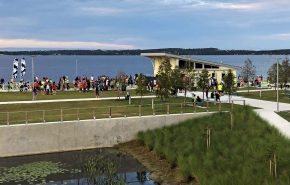![]() Parks are the heart of our communities and our quality of life—where neighbors, friends, and family can interact freely.
Parks are the heart of our communities and our quality of life—where neighbors, friends, and family can interact freely.
Every time I’m involved with public outreach relating to parks and recreation, community residents tell me about the importance of safety. Perhaps their concern is partially a sign of our times, but assuming that the most meaningful connection residents have with their government is generally through parks and recreation, it is of the utmost importance that residents feel safe using their local parks.
Parks Increase Home Property Values
Property values are higher based on a home’s proximity to a park. The National Association of Realtors reports that 57% of voters would choose a home closer to parks and open space over one that was not. In addition, the survey found that 50% of voters are willing to pay 10% more for a house located near a park or open space. The National Association of Homebuilders found that 65% of home buyers felt parks would seriously influence their decision to move to a community. In fact, it is very common for realtors to market properties based on their proximity to parks, and if that tendency continues, it is extremely important that our neighborhood parks are clean and safe.
Crime Prevention Through Environmental Design
Crime Prevention Through Environmental Design, or CPTED (pronounced SEP-TED), is a unique way to synthesize good planning and design standards with crime prevention programs in communities. A park’s design can have a direct impact on the public’s perception of safety and their ultimate willingness to use the park. Utilizing a comprehensive approach, a CPTED practitioner can evaluate parks and make recommendations on their compliance with accepted CPTED strategies, such as natural surveillance, natural access control, and territorial reinforcement.
- Natural Surveillance—Designing areas where people and their activities can be regularly observed, and law enforcement and the “normal user” can easily have eyes on the park space.
- Natural Access Control—Controlling access to a site by clearly defining park entranceways and exits. For example, a “celebrated entry” as a primary means of ingress and egress helps staff and users know where people should come and go.
- Territorial Reinforcement—Creating areas that promote a sense of ownership—branding public spaces so the user knows they are in their local park (e.g., implementing a common amenity package throughout a system, such as signage, benches, and trash receptacles).
Among the numerous benefits to parks, CPTED can help increase patronage, reduce maintenance costs, and give the community greater satisfaction and safety—ultimately creating better places to live, work, and play.
![]() GAI Director of Park System Planning Kristin Caborn, CPRE, FCP is a certified CPTED practitioner with extensive parks and recreation management and planning experience. She has managed several multimillion-dollar parks and recreation projects and provided master plan implementation and phasing plans services for public-sector clients.
GAI Director of Park System Planning Kristin Caborn, CPRE, FCP is a certified CPTED practitioner with extensive parks and recreation management and planning experience. She has managed several multimillion-dollar parks and recreation projects and provided master plan implementation and phasing plans services for public-sector clients.


